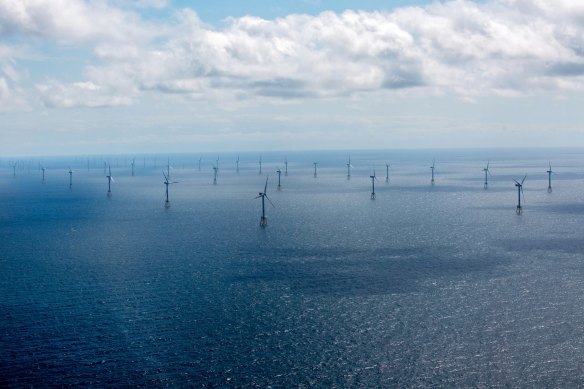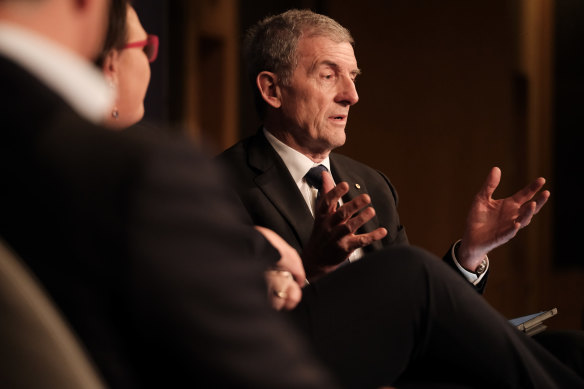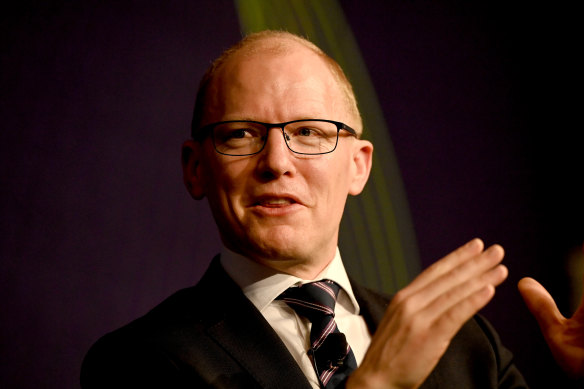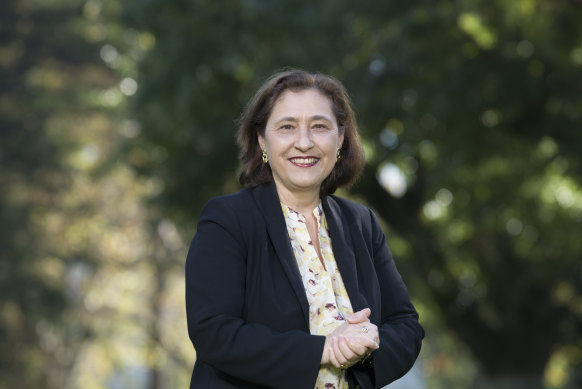The hurdle preventing Australia from ‘worldwide feat’ on renewable energy
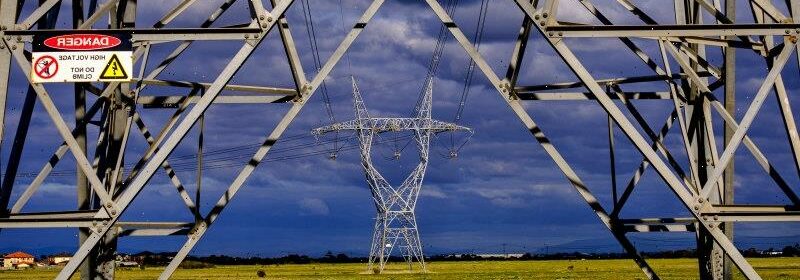
Key points
- The Australian Energy Market Operator (AEMO) is predicting that by 2025 there will be enough periods where there is enough renewable energy available to meet 100 per cent of demand.
- But AEMO is warning of the urgent need for new transmission infrastructure, and to invest in new technology, to handle the extraordinary increase in intermittent renewable energy.
- AEMO modelling shows Victoria will face power reliability gaps as early as 2024, with minimum reliability standards expected to be breached in Victoria from 2028 onwards.
The east-coast electricity grid could be operating for periods using only renewable energy in less than three years if transmission infrastructure is urgently upgraded to handle the surge of intermittent wind and solar energy.
The Australian Energy Market Operator (AEMO) has launched a detailed engineering blueprint for the east-coast electricity grid, predicting that by 2025 there will be enough renewable energy available – at certain times – to meet 100 per cent of demand.
Victoria is ramping up efforts to encourage off-shore wind projects. But that will require new poles and wires.Credit:Bloomberg
AEMO chief executive Daniel Westerman said operating a “gigawatt-scale power system” using only instantaneous wind and solar energy would be “a feat unparalleled worldwide”.
But with the system already under pressure, AEMO has grown increasingly vocal about the need to “urgently” build new transmission infrastructure, and invest in new technology, to handle the extraordinary rapid increase in intermittent energy.
By 2030, at least five coal-fired power stations, currently responsible for generating about 14 per cent of the east-coast grid’s current power, are expected to shut, with others to quickly follow, including Victoria’s Loy Yang A plant in 2035. This, AEMO says, will challenge the network’s reliability, with renewable energy sources scattered around different parts of the country.
Grattan Institute energy program director Tony Wood said there was “a long, long way to go” preparing the grid to handle very high levels of renewables over the next few years.
“It looks to be a very difficult challenge, and if we are going to be able to ramp up as fast as these new, more aggressive, [emissions reduction] targets would suggest, then it is going to have to be done sooner rather than later,” Wood said.
Tony Wood, Grattan Institute energy and climate change program directorCredit:Oscar Colman
“You are talking about a system that is fundamentally going to be wind and solar. One way we are going to be able to deal with more wind and solar is to build the transmission system, and we are way behind where we need to be doing that. That would enable us to move energy around the grid to manage some of the imbalances.”
In an effort to shore up the reliability of the grid, state, territory and federal energy ministers this week agreed to a new “capacity mechanism”, under which the Commonwealth will run auctions for dispatchable back-up generation from batteries and pumped hydro, but not gas or coal.
Business Council chief executive Jennifer Westacott said the decision to exclude gas and coal from the mechanism “will limit its ability to drive stability, certainty and reliability”.
In a bid to curb soaring power prices, Prime Minister Anthony Albanese on Friday announced that the government will spend up to $1.5 billion to provide “nationally targeted” power bill relief to households and small businesses.
Under the plan, agreed to at a meeting of national cabinet, parliament will also be recalled before Christmas to pass laws to cap gas price for generators and other big energy users at $12 per gigajoule for a year. Coal prices in Queensland and NSW will be capped at $125 per tonne, about half the rate on the spot market.
Based on existing and committed projects, AEMO modelling shows Victoria will face power reliability gaps as early as 2024, with minimum reliability standards expected to be breached in Victoria from 2028 onwards. New South Wales is expected to breach the minimum standard from 2025.
In a statement provided to The Age and The Sydney Morning Herald, AEMO said renewables with back-up firming generation from batteries and pumped hydro would be required to replace retiring coal, meet emissions targets, and keep essential electricity secure, reliable and affordable.
But it warned: “These investments are only enabled by new transmission lines.”
Westerman has also suggested that the computer software used by AEMO to manage the grid is badly out of date, and no longer equipped for the complex task of managing renewable energy from geographically diverse and less-predictable sources.
“Visiting the control rooms of leading system operators across Europe and the US has been a stark reminder that their advanced control systems are providing greater visibility and control of these complex electricity networks, and yet at AEMO, our control software is reaching the end of its life,” he said in a recent speech to the Australian Financial Review’s energy and climate summit.
Daniel Westerman, chief executive of the Australian Energy Market Operator. Credit:Jeremy Piper
“We need to upgrade our forecasting and real-time control systems to ensure we continue to provide Australian energy consumers with secure, reliable energy supply.”
Among other things, AEMO is warning the equivalent of up to 40 “large synchronous condensers” will be needed within the next three years to stabilise the load placed on the east-coast grid by renewables. Synchronous condensers (or equivalent technologies) are machines that regulate the flow into the grid, similar to turbines at coal-fired power plants, which produce steady pulses of energy.
Renewable energy expert Tristan Edis, director of analysis at Green Energy Markets, said by 2025 Australia would realistically have enough renewables capacity installed to get close to periods of 100 per cent renewables for short bursts of time.
But he warned far more work was needed, including allowing power generated by wind to be transported to and from Queensland.
“Wind generation in Queensland tends to have a different pattern to it than in the southern states,” Edis said. “In South Australia and Victoria the wind farms are very closely aligned, so they experience similar weather patterns. You want to be able to transport power from north to south and south to north to give you a greater overall stability in power generation from wind.”
Victorian Energy Minister Lily D’Ambrosio said the state government was investing in transmission needed to deliver 95 per cent renewable energy by 2035.
Victorian Energy Minister Lily D’Ambrosio.Credit:Elke Meitzel
“We’re engaging with communities and stakeholders on how renewable energy can deliver a range of opportunities for regional Victoria including local jobs and upskilling, as well as how landholders affected can share the benefits of this transition,” she said.
For months the Andrews government has been spruiking its plans to reboot Victoria’s State Electricity Commission, which was carved up and sold off in the 1990s, as a renewable energy company.
In the lead-up to the state election, it announced a $1 billion taxpayer funded contribution to the commission to initially generate about 4.5 gigawatts of renewable energy, enough to replace AGL’s ageing Loy Yang A coal-fired power plant.
The government says the state will have a 51 per cent controlling stake in the commission, with the remaining 49 per cent of investment expected to come from “like-minded” industry superannuation funds.
The promise to use profits from the SEC to drive down power bills was said to be wildly popular during the recent state election campaign.
But beyond the branding, there are few details, including whether the commission would be set up as a public business entity operating at arm’s length from the government with an independent board.
In the absence of that detail, industry superannuation funds have been publicly cautious about the idea of teaming up with the state government, given their responsibility to maximise returns for members.
Victoria and the Commonwealth announced a $2.25 billion plan in October to modernise the state’s electricity grid, and massively expand the offshore wind industry.
As part of the plan, the Commonwealth’s Clean Energy Finance Corporation will provide a concessional loan of $750 million to help build the much-anticipated KerangLink inter-connector, a massive new high-capacity, high-voltage overhead transmission line running between Victoria and NSW.
The project, likely to cost about $3.3 billion in total, would connect Victoria’s Western Renewables Link (at a proposed terminal north of Ballarat) with Project EnergyConnect (at Dinawan) via new stations near Bendigo and Kerang.
It would mean power stored by the Snowy 2.0 hydropower project in the Snowy Mountains could be transferred to Victoria, while power generated by new Victorian offshore wind farm projects in the Bass Strait could be sent north.
The state government has also announced $540 million to set up Renewable Energy Zones to help new projects connect to Victoria’s grid.
The Morning Edition newsletter is our guide to the day’s most important and interesting stories, analysis and insights. Sign up here.
Most Viewed in National
From our partners
Source: Read Full Article
